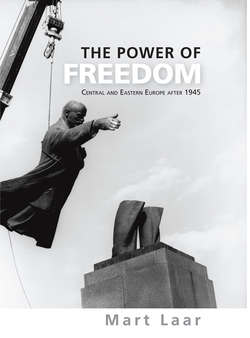The Power of Freedom

Реклама. ООО «ЛитРес», ИНН: 7719571260.
Оглавление
Mart Laar. The Power of Freedom
Author
Acknowledgments
Foreword
On the other side of the curtain
The old New Europe
Between two evils: Central and Eastern Europe during the Second World War
Back to the shadow: the Communist takeover and the Red Terror
Usual Communism
East and West compared
Towards Freedom! The Fight against Communist Domination
The fight begins: the start of the Cold War
The forgotten war: armed resistance to Communism 1944-1956
East Germany 1953
The lost opportunity: 1956
Prague, 1968
Turning the tide: a Polish Pope and Solidarity
Winning the Cold War
A new start: the Singing Revolution
1989: revolutions in Central and Eastern Europe
The fall of the Soviet Empire
The new start
The heavy heritage of Communism
Out of the Red fog: political developments in Central and Eastern Europe after the fall of Communism
Just do it: economic and political reforms in transition countries during the 1990s
The Vilnius Express: the former Communists return to power
In from the cold: the results of the reforms at the end of the millennium
First lessons
Europe’s historic unification
First steps back to Europe
The crucial Copenhagen Council
Applications for accession and different paces in Luxembourg
Negotiations and the decision in favour of ‘Big Bang’ enlargement
The people say yes
The end of a divided Europe
NATO becomes the central axis of security
Western allies and Russia
NATO’s Baltic dilemma
Breakthrough and NATO enlargement
Freedom works: Central and Eastern Europe during the new millennium
Politics as usual: political developments in Central and Eastern Europe
Economic development in Central and Eastern Europe during the new millennium
The results of 20 years of freedom
Freedom still works: new challenges for a ‘new’ Europe
Conclusion
Annex 1
Annex 1
Annex 2
Annex 2
Annex 3
Annex 3
Annex 4
Annex 4
Annex 5
Annex 5
Annex 6
Annex 6
Annex 7
Annex 7
Annex 8
Annex 8
Annex 9
Annex 9
References
Отрывок из книги
Scores of books have been written on topics related to the Cold War, the Fall of Communism and the transition of captive nations into democracies. Most of these books have been written by people from the side of the Iron Curtain where freedom and prosperity were enjoyed. But considering the events of 1989 and the ensuing developments, a different perspective is in order. It is important to understand what the citizens of Central and Eastern Europe felt and thought under Communism and how they brought the Evil Empire to its long overdue end.
This book would never have been possible without the help of numerous people and organisations. First and foremost I am indebted to the Centre for European Studies, whose aid and cooperation enabled us to accomplish this enormous task. Roland Freudenstein, Tomi Huhtanen, Katarína Králiková and many others provided invaluable help in the process. My gratitude also belongs to the Unitas Foundation, which worked hard to make this “mission impossible” possible. Many thanks go to Uve Poom, Veiko Lukmann, Heiko Unt, Sophie Williams and Henri Perkmann, among others.
.....
The growing number of arrests throughout the region resulted in the establishment of a system of concentration camps. In the early 1950s, there were 422 concentration camps in Czechoslovakia63 in which people were held under gruesome conditions. In 1950, the number of prisoners in such camps amounted to 32,638 men and women. Zbigniew Brzezinski identified 199 in Hungary and 97 in Poland. Many Central and Eastern European people were arrested by the Soviet authorities, interrogated, sentenced in the Soviet Union and sent to the GULAG. Some Central and Eastern European countries had their own ‘Siberia’ as well: the Danube-Black Sea Canal project in Romania employed prisoners and deported persons; in Poland, special units made up of political prisoners mined the most deadly coal shafts in Silesia; in Czechoslovakia, prisoners were sent to work in uranium mines – in December 1953, the number of people working there reached 16,100.64
Another typical feature of Stalinism were the purges of the Communist parties in the conquered countries; the most violent of these took place in Bulgaria, Hungary and Czechoslovakia. According to Brzezinski, an average of one out of every four party members was purged in each of the East European parties.65 In Bulgaria, for example, nearly 100,00 °Communist Party members were under investigation between 1948 and 1953; many were imprisoned and some executed. Such purges were also organised in the Soviet Union’s ‘new territories’. In Estonia, a campaign was launched against the ‘bourgeois nationalists’ in 1950-1951; a number of leading Estonian Communists were removed from their positions and several of them were arrested and sent to the Siberian prison camps. The campaign also hit cultural circles. Most of the members of the Academy of Sciences were dismissed and creative unions underwent serious ‘clean-ups’. Repression was so severe that almost no new Estonian literature appeared from 1950 to 1952.66
.....